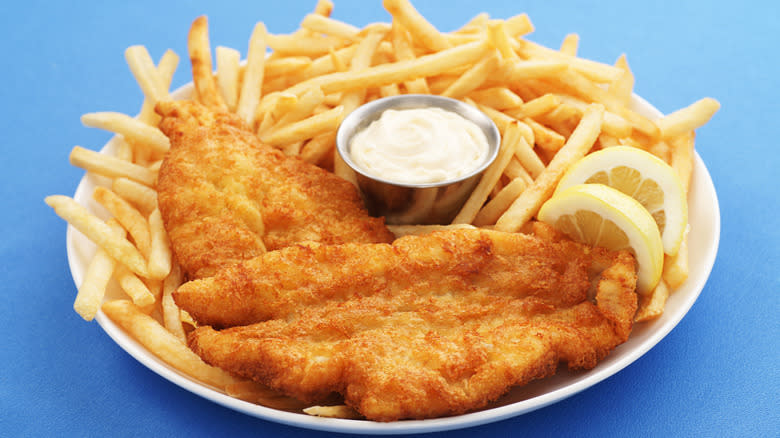How Salt And Vinegar Came To Dominate The Chip World

We live in an age when we've long passed the concept of basic plain potato chips. There are a lot of flavors out there; in addition to old standbys like barbecue and sour cream and onion, you can easily find flavors like flamin' hot, dill pickle, and even cappuccino. But one flavor seems to rule the roost among chip aficionados, especially lately: Salt and vinegar. It may only be the fourth-most popular chip flavor (unaccountably, plain has the heavy lead), but adherents to salt and vinegar love it with the passion of a thousand burning suns. But where did that flavor combo even come from in the first place? Who first thought, "I should put salt and also vinegar on there" while looking at a potato chip?
The answer, it turns out, dates back to the British love of french fries (they call them chips, but it's the same dish) and their use of flavorings. It turns out that salt and malt vinegar is a very classic flavor combo that's been around so long that we're not even sure where it started; it's just something people have done for a long time. But we do know when it transitioned to chip form: After powdered vinegar became a thing.
Read more: The Most Beloved Products At Aldi, According To Shoppers
Salt And Acid Balance Each Other Out

It makes sense that salt and vinegar work as a combo. They're both robust flavors, but acid and salt enhance and balance each other rather than conflict; it's why the recommended solution for an oversalted dish is often to add some lemon juice. So it only made sense that salt and vinegar -- each of which works well on potatoes but which amplifies each other when paired -- were long-established condiments at British chip shops. There's no available specific history here as far as food historians can tell; it's just a thing that's been true for as long as people can remember.
When the transition to flavored potato chips started in the 1950s, salt and vinegar were among the first flavor combos. In that decade, Irish potato chip company owner Joe Murphy (nicknamed "Spud" for obvious reasons) of the Tayto brand came up with a process to flavor potato chips. Salt and vinegar were one of the first flavors he went with. Though it took a while for them to reach other countries (including the U.K., where they arrived in 1967), they've been a staple of the international potato chip roster ever since, with pretty much every brand worth its salt having its own version.
Salt And Vinegar Chips Have A Dedicated Fan Base

In the decades since its creation, a lot of flavors have come and gone -- spring onion (aka green onion) was a popular flavor in the '80s, although you pretty much never see it now. But salt and vinegar has stood the test of time far longer than most, in large part for the simple reason that it has a built-in base. People who hate it are never going to buy it, sure, but a lot of the people who love it might never buy any other flavors. You can't really say the same about, say, sour cream and onion.
Any great flavor combination will provide multiple tastes that balance rather than conflict with each other, so it's no surprise salt and vinegar is as popular as it is. Though chip flavors may rise and fall, salt and vinegar isn't going anywhere, as evidenced by having a history so old we don't even know when it started.
Read the original article on Daily Meal.

